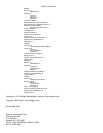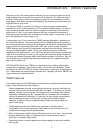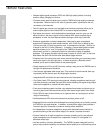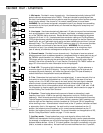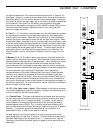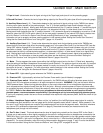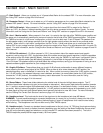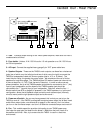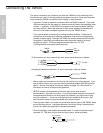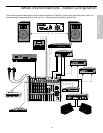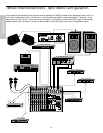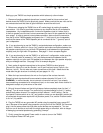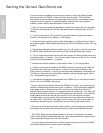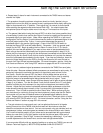
Guided Tour - Main Section
17: Bank Control - Allows you to select any of 16 preset effect Banks for the onboard DSP. For more information, see
the “Using DSP” section on page 22 of this manual.
18: Parameter Control - Allows you to select any of 16 variation parameters on the preset effect Bank selected for the
onboard DSP (see #17 above). For more information, see the “Using DSP” section on page 22 of this manual.
19: DSP On/Off switch - When pressed in (“On”), output signal from the internal DSP is routed to Aux Return 2.
When up (“Off”), Aux Return 2 instead receives signal from any device connected to the Aux Return 2 jacks. For more
information, see the “Using the Aux Sends and Returns” and “Using DSP” sections on pages 20 and 22 in this manual.
20: Aux 1 / Monitor switch - When pressed in, Aux send 1 is routed to the right side of the TM500’s power amplifier and
the stereo mix is automatically combined to mono and routed to the left side of the TM500’s power amplifier. This allows
the TM500 to be used in a “split mono” configuration, so that it can drive both main “Front Of House” PA speakers (from
the left speaker output ) and onstage monitors (from the right speaker output) without the need for any external power
amplifier. When used in a “split mono” configuration, the Rev To Aux 1 Level knob allows you to route signal from the
internal DSP to your onstage monitors (the signal can also be routed to Aux Return 2 for simultaneous use in the main PA
signal). For more information, see the “Using the Aux Sends and Returns” and “Using DSP” sections on pages 20 and 22
in this manual.
21: EQ On/ Off switches (L, R)- When pressed in (“On”), the equivalent side of the master seven-band graphic
equalizer is active; when out (“Off”), the equivalent side of the master seven-band graphic equalizer is inactive regardless
of the settings of the EQ sliders (see #22 below). Note that, when using the TM500 in a “split mono” configuration (that is,
when the Aux 1 / Monitor switch [see #20 above] is pressed in), the left side of the graphic equalizer affects the main
“Front Of House” PA speakers and the right side affects the onstage monitors, saving you the expense of having to use a
separate outboard graphic equalizer for your onstage monitors.
22: Graphic EQ sliders - These sliders allow you to add 12 dB of boost or attenuation to seven different frequency
areas, affecting the main output signal of the TM500. When a slider is at its center detented (“0 dB”) position, the
selected frequency area is unaffected (it is said to be flat). When a slider is moved up (above the “0 dB” position, towards
the “+12 dB” position), the selected frequency area is boosted, and when it is moved down (below the “0 dB” position,
towards the “-12 dB” position), the selected frequency area is attenuated. For more information, see the “Using
Equalization” section on page 18 in this manual.
23: Stereo Faders - These linear sliders determine the relative level of the main left/right stereo outputs. The “0”
position of each fader indicates unity gain (no level boost or attenuation). Moving each fader below this position (towards
the “∞” position) causes the signal to be attenuated (at the very bottom, it is attenuated infinitely—in other words, there is
no sound). Moving it above this position (towards the “+10 dB” position) causes the signal to be boosted by up to 10 dB.
For best signal-to-noise ratio, both Stereo faders should generally be kept at or near the 0 level. For more information,
see the “Setting The Correct Gain Structure” section on page 14 in this manual.
24: Headphone Level - This knob sets the level of the signal sent to the headphone jack (see #25 below).
WARNING: To avoid possible damage to connected headphones (or, worse yet, to your ears!), always turn this all the
way off (to the fully counterclockwise “0” position) before plugging in a pair of headphones—then raise the level slowly
while listening. The Headphone Level has no effect on any other TM500 outputs.
25: Headphone jack - Connect any standard stereo headphones to this jack (via a 1/4" TRS plug) for private monitoring
of the stereo output, Aux sends, or soloed channels (depending upon the setting of the Meter Headphone Source switch
[see #15 on the preceding page] and whether or not any channel PFL switches have been pressed in). The built-in
TM500 headphone preamp delivers approximately 100 mw of power.
10
ENGLISH



